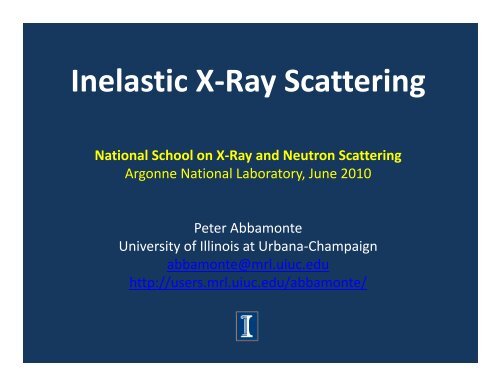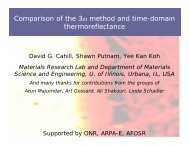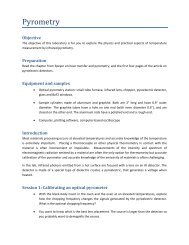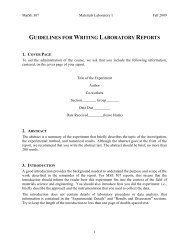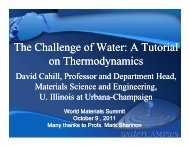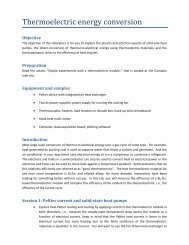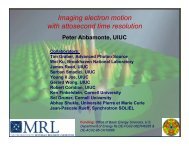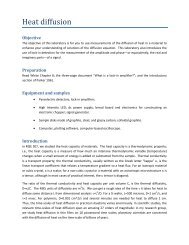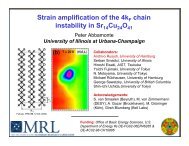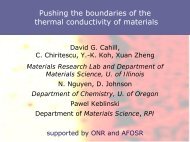Inelastic X-Ray Scattering - University of Illinois at Urbana-Champaign
Inelastic X-Ray Scattering - University of Illinois at Urbana-Champaign
Inelastic X-Ray Scattering - University of Illinois at Urbana-Champaign
- No tags were found...
You also want an ePaper? Increase the reach of your titles
YUMPU automatically turns print PDFs into web optimized ePapers that Google loves.
Comparison to other techniques<strong>Inelastic</strong> Neutron <strong>Sc<strong>at</strong>tering</strong>• Low energy probe ( i = 25 meV)• Better energy resolution• Couples only to nuclei and spins• Not sensitive to charge excit<strong>at</strong>ions(e.g. plasmons)• Large samples required<strong>Inelastic</strong> Electron <strong>Sc<strong>at</strong>tering</strong>• Can focus beam ~ 1Å• Decent energy resolution (0.5 eV)• Sample damage• Multiple sc<strong>at</strong>tering• Does not work in H 0• Requires UHVLight (Raman) <strong>Sc<strong>at</strong>tering</strong>• q=0 probe• Super high energy resolution (0.1 meV)• Super high flux (10 22 photons/sec on sample)• Polariz<strong>at</strong>ion selection rules• cheap
Instrument<strong>at</strong>ion: Overviewkk 2Requirements / Challenges• Cross section small: only 1 in 10 8 photons are inelasticallysc<strong>at</strong>tered –high flux needed2 • Very high resolving power needed. 2 meV / 20 keV = 10 ‐7k ik kq = k 1 – k 2• Must be able to tune energy; both 1 and 2 for RIXS• Broad angular acceptance required for enough signalBacksc<strong>at</strong>teringanalyzerMonochrom<strong>at</strong>icbeamWhite beam from APS undul<strong>at</strong>orsc<strong>at</strong>tering angleSpecimen
Instrument<strong>at</strong>ion: SourceSpring‐8 (Hyogo, Japan)ESRF (Grenoble, France)Advanced Photon Source(Chicago, IL, USA)
Instrument<strong>at</strong>ion: SourceSector 9Electronicexcit<strong>at</strong>ions / RIXSSector 30BothSector 3Phonons
Instrument<strong>at</strong>ion: Sector 30 XOR‐IXS SpectrometersMERIXE = 10‐100 meVElectronic excit<strong>at</strong>ions:ti• plasmons• excitons• Mott‐gap excit<strong>at</strong>ions• two‐magnonsHERIXE = < 1 meVVibr<strong>at</strong>ion modes:• acoustic phonons (sound)• optical phonons
Instrument<strong>at</strong>ion: Monochrom<strong>at</strong>orBragg’s law:2d sin = bandpassDarwinwidthDumonddiagramTunable byrot<strong>at</strong>ing crystalsin a coordin<strong>at</strong>edfashion.
Instrument<strong>at</strong>ion: AnalyzerBacksc<strong>at</strong>tering• Need “curved” crystal to acceptlarge Mosaic <strong>of</strong> ~10 4 aligned blocksGlued on spherical surfaceUsed near backsc<strong>at</strong>tering• Slightly tunable by rot<strong>at</strong>ing angle
IXS Example 1: ExcitonsB. C. Larson, et. al., Phys. Rev. Lett. 99,B. C. Larson, et. al., Phys. Rev. Lett. 99,026401 (2007)
IXS Example 2: Plasmons in graphite and grapheneA. H. Castro‐ Neto, et al., Rev. Mod. Phys. 81, 109 (2008)
IXS Example 2: Plasmons in graphite and graphenei( x, ) nˆ( x, t), nˆ(0,0) ( t)(0,0)(x,t)J. P. Reed, et al., submitted
RIXS Example 1: Crystal field excit<strong>at</strong>ions in SrCuO 2A. Higashiya et. al., J. Elect. Spect. Rel. Phen. 144‐147, 147 685 (2005)
RIXS Example 2: Magnons in La 2 CuO 4J. P. Hill, et. al., Phys. Rev. Lett. 100, 097001 (2008)
The Future• Join mainstream <strong>of</strong> experimental probes (with STEM, ARPES, etc.)• Imaging• Strip detectors (no more analyzers?)• Surface dynamics [B. Murphy, et. al., Phys. Rev. Lett. 95, 256104(2005)]• High pressure (fluctu<strong>at</strong>ions near quantum phase transitions)• ??? New ideas from new people.


